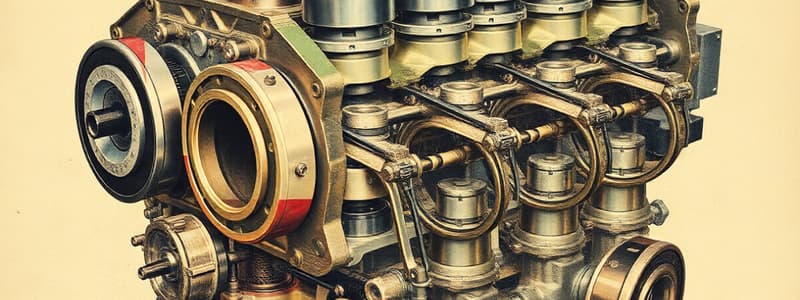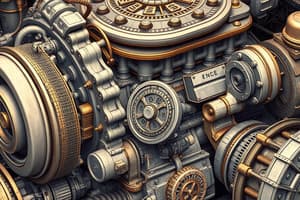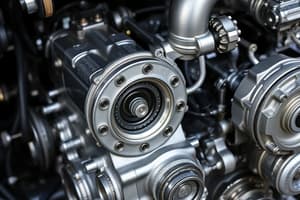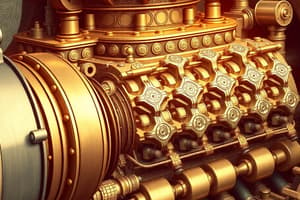Podcast
Questions and Answers
How does a DOHC (Dual Overhead Cam) engine differ from an engine with a single overhead cam?
How does a DOHC (Dual Overhead Cam) engine differ from an engine with a single overhead cam?
- DOHC engines use pushrods to actuate the valves, while single overhead cam engines do not.
- DOHC engines always have more than four cylinders, whereas single overhead cam engines are limited to four.
- DOHC engines have two camshafts, one for intake valves and one for exhaust valves, allowing for more precise control. (correct)
- DOHC engines use a timing chain, while single overhead cam engines use a timing belt.
What role do cam lobes play in determining an engine's performance characteristics?
What role do cam lobes play in determining an engine's performance characteristics?
- They regulate the pressure of oil supplied to the engine's bearings.
- They dictate the timing and extent of valve opening, influencing horsepower, torque, and fuel economy. (correct)
- They adjust the air-fuel mixture entering the combustion chamber.
- They control the flow of coolant through the engine block.
What is the primary advantage of using hydraulic lifters in a valve train?
What is the primary advantage of using hydraulic lifters in a valve train?
- Reduced friction and wear on the camshaft
- Quieter engine operation (correct)
- Increased engine power at high RPMs
- More precise valve timing
How is the distributor timed in relation to the engine's cylinders, and what is its function?
How is the distributor timed in relation to the engine's cylinders, and what is its function?
What is the purpose of using equal length runners on an exhaust manifold?
What is the purpose of using equal length runners on an exhaust manifold?
What is the crucial role of the timing belt in an internal combustion engine?
What is the crucial role of the timing belt in an internal combustion engine?
How does the length and diameter of intake manifold runners affect engine performance?
How does the length and diameter of intake manifold runners affect engine performance?
In fuel-injected engines, how does the delivery of fuel differ from that in carbureted engines?
In fuel-injected engines, how does the delivery of fuel differ from that in carbureted engines?
What role does the shape and size of the combustion chamber play in engine performance?
What role does the shape and size of the combustion chamber play in engine performance?
What is the function of valve springs in an internal combustion engine?
What is the function of valve springs in an internal combustion engine?
What is the potential consequence of valve float in a high-RPM engine?
What is the potential consequence of valve float in a high-RPM engine?
What is the purpose of valve seals, and what can result from their failure?
What is the purpose of valve seals, and what can result from their failure?
How do flywheels and flex plates differ in their application within an engine?
How do flywheels and flex plates differ in their application within an engine?
In a four-cylinder engine, what does the term "sister cylinders" refer to?
In a four-cylinder engine, what does the term "sister cylinders" refer to?
What is the function of the oil pickup in an engine's oil pan?
What is the function of the oil pickup in an engine's oil pan?
What is a harmonic balancer, and what is its main function in an engine?
What is a harmonic balancer, and what is its main function in an engine?
What does "power at the flywheel" refer to?
What does "power at the flywheel" refer to?
What is the purpose of piston rings in an internal combustion engine?
What is the purpose of piston rings in an internal combustion engine?
Why are there often grooves on the top of a piston?
Why are there often grooves on the top of a piston?
What is a primary limitation of internal combustion engines that contributes to their inefficiency?
What is a primary limitation of internal combustion engines that contributes to their inefficiency?
Flashcards
Camshafts
Camshafts
Controls valve functions, located under the valve cover.
DOHC (Dual Overhead Cam)
DOHC (Dual Overhead Cam)
An engine design with two camshafts in the cylinder head, one for intake valves and one for exhaust valves.
Cam lobes
Cam lobes
Dictate when and how far valves open, impacting engine performance characteristics.
Pushrod Engine
Pushrod Engine
Signup and view all the flashcards
Distributor
Distributor
Signup and view all the flashcards
Timing Belt
Timing Belt
Signup and view all the flashcards
Fuel Rail
Fuel Rail
Signup and view all the flashcards
Combustion Chamber
Combustion Chamber
Signup and view all the flashcards
Valve Seals
Valve Seals
Signup and view all the flashcards
Flywheel
Flywheel
Signup and view all the flashcards
Oil Pickup
Oil Pickup
Signup and view all the flashcards
Crankshaft
Crankshaft
Signup and view all the flashcards
Harmonic Balancer
Harmonic Balancer
Signup and view all the flashcards
Torque at the Flywheel
Torque at the Flywheel
Signup and view all the flashcards
Piston Rings
Piston Rings
Signup and view all the flashcards
Study Notes
Engine Basics: Parts and Function
- An engine's basic parts and their functions are explained.
- The engine shown is a 1.8-liter Honda engine from a 1990 Acura Integra.
- Motor is an electrical component, while engine is short for ingenious device.
Valve Cover and Camshafts
- Under the valve cover are the camshafts, controlling valve functions.
- This engine has a dual overhead cam (DOHC) design.
- A water pump is connected to the DOHC system.
- DOHC engines have two camshafts, one for exhaust and one for intake.
- The exhaust camshaft controls exhaust valves, the intake camshaft controls intake valves.
- The intake manifold is on the intake side, the exhaust manifold on the exhaust side.
Camshafts and Valve Operation
- Camshafts, or "bump sticks," determine engine breathing.
- Cam lobes dictate when and how far valves open, impacting horsepower, torque, and fuel economy.
- The camshaft is mechanically timed with timing gears.
- The camshaft can be considered a mechanical computer program for the engine.
- Cam lobes push followers to open valves.
- This engine has two valves per cylinder, totaling 16 valves for a four-cylinder engine.
Valve Train Variations
- Pushrod engines use lifters to open valves.
- Hydraulic lifters filled with oil allow for quieter operation.
- Solid valve trains offer more accurate timing but require periodic adjustment.
- A push rod sits inside a cup on the lifter and is pushed by the cam to open the valve.
- Overhead cam engines are designed to activate the valves.
Timing and Distribution
- The back of the intake camshaft has a slot that drives a distributor.
- The distributor is mechanically connected to the camshaft and may be connected to the oil pump.
- The distributor transfers spark to each cylinder as it comes up on its compression stroke.
Oil Pump and Exhaust Manifold
- An old-school oil pump is driven by a long shaft connected to the distributor.
- Oil pumps and distributors are often tied together.
- The exhaust manifold has runners from each cylinder that collect into the manifold.
- Equal length runners ensure each cylinder produces equal power.
Crankshaft and Timing Belt
- The camshafts keep the top part of the engine in time, while the crankshaft keeps the bottom in time.
- A timing belt connects the crankshaft and camshafts.
- The water pump, driven by the timing belt, circulates water throughout the engine.
- A tensioner maintains tension on the timing belt.
Timing Chain and Gears
- Older V8 engines use a timing chain to connect the camshaft and crankshaft.
- The camshaft gear is larger, rotating once for every two crankshaft revolutions.
- Double roller timing chains are stronger.
- Gear-driven setups are more accurate but noisier, diesels are often designed this way from the start.
Intake Manifold
- The intake manifold has runners to each cylinder of the same length.
- Long, narrow intake manifold runners are good for low-end torque.
- Short, wide runners are made for higher RPM horsepower.
- Long and narrow runners increase air velocity into the cylinder.
- Big open areas allow the engine to draw in more air at higher RPMs.
Fuel Injection
- Fuel injectors spray fuel into individual cylinders at the correct time.
- A fuel rail supplies pressurized fuel behind the injectors.
- The engine computer uses sensors to determine when to inject fuel.
- In fuel-injected engines, air flows to the cylinder, and fuel is added at the last second.
- Carbureted engines have air and fuel mixed in the runners leading to the cylinders.
Cylinder Head and Combustion Chamber
- The cylinder head is connected to the block with a head gasket guided by dowels.
- The combustion chamber's shape and size vary, affecting engine performance.
- Hemi engines have hemispherical combustion chambers.
- "Penta roof" combustion chambers have a sharp angled design.
- The design and angle of valves all influence engine performance.
- Engineers balance fuel economy and power when designing the engine.
Valve Components and Function
- Valve components include the valve, valve spring, and keepers.
- Keepers sit in a groove and are tapered to wedge and hold the valve.
- The valve spring closes the valve after the camshaft compresses it.
- Valve springs must combat the forces opposing them and rapidly re-expand to close the valve.
Valve Float and Valve Springs
- Valve float occurs when the spring cannot close the valve fast enough.
- Valve springs affect high RPM engines and the ability to close the valves in milliseconds.
- Stronger valve springs can put more stress on the cam and valve train.
- If valve springs are too weak, valves will stay open, leading to compression loss, power loss, and engine issues.
Valve Seals
- Valve seals, positive type seals, lock onto the valve guide.
- Bad valve seals can lead to oil being sucked into the cylinder.
- Umbrella seals sit inside the valve to keep oil out.
- Worn valve guides can increase oil consumption.
Flywheel and Flex Plate
- A flywheel is a weighted component used with manual transmissions.
- A flex plate, thinner, and lighter, is used with automatic transmissions.
- Automatic transmissions utilize flex plates.
Piston Movement and Firing Order
- In a four-cylinder engine, pistons fire every 180 degrees.
- Sister cylinders refer to pistons that move up at the same time due to crankshaft design.
Oil Pan and Oil Pickup
- An oil pickup in oil pan sucks oil into the oil pump and the engine.
- The oil pump, driven by the crankshaft, circulates oil.
- A windage tray in the pan scrapes oil off the crankshaft to improve efficiency.
- A screen on the oil pickup prevents large particles from entering the pump.
Crankshaft and Pistons
- The crankshaft turns chemical energy into mechanical energy.
- Counterweights help balance four-cylinder engines.
- Connecting rods link pistons to the crankshaft.
- Harmonic balancers dampen pulses created by piston movement and rotation that is transferred to the crankshaft.
Harmonic Balancer
- Harmonic balancers dampen accelerating and decelerating forces within the crankshaft.
- Dampening prevents the engine from shattering due to force.
Power at the Flywheel
- Power at the flywheel refers to the twisting force (torque) at the back of the engine.
- Torque indicates an engine's ability to push down bigger cylinders.
- Connecting rods transfer power to the crankshaft.
Pistons and Cylinders
- Pistons move within cylinders, creating displacement.
- Displacement is volume between cylinders and pistons.
Piston Rings
- Shiny spot is called the skirt
- Pistons have an oil control ring and two compression rings.
- Piston rings seal against the cylinder walls.
- The wrist pin allows the connecting rod to pivot as the piston moves.
Valve Grooves
- Grooves on top of the piston allow clearance for valves. The valves may be close when the piston rises to the top.
Oil Holes
- Small holes in the piston lubricate the area and cool the piston.
Internal Combustion
- Internal combustion engines convert chemical energy to mechanical energy, only 20% efficient.
- 80% of the heat generated is lost through friction and other factors.
- Moving a piston up and down is inefficient.
- The internal combustion engine is not very efficient. However, the process has been refined significantly.
Studying That Suits You
Use AI to generate personalized quizzes and flashcards to suit your learning preferences.




